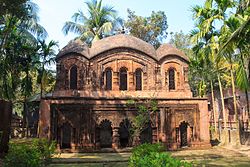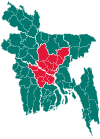Rajoir Upazila
Rajoir
রাজৈর | |
|---|---|
 Rajaram Mandir, Rajoir | |
 | |
| Coordinates: 23°12.5′N 90°2′E / 23.2083°N 90.033°E | |
| Country | |
| Division | Dhaka |
| District | Madaripur |
| Area | |
• Total | 229.27 km2 (88.52 sq mi) |
| Population | |
• Total | 245,316 |
| • Density | 1,100/km2 (2,800/sq mi) |
| Time zone | UTC+6 (BST) |
| Postal code | 7910[2] |
| Area code | 06623[3] |
| Website | rajoir |
Rajoir (Bengali: রাজৈর) is an upazila of Madaripur District in the Division of Dhaka, Bangladesh.
Archaeological heritage and relics Sarmangal Mosque, Annapurna Mandir (1765), Khalia Rajaram Mandir (1825), temple of Ganesh Pagal, Patitapaban Sebasrama Mandir, Pranab Math (Bajitpur).
Historical events Ambikacharan Majumdar of village Sendia in Rajoir upazila formed the first political party of East Bengal in 1881called ‘Faridpur Peoples Association’. In 1918 he established the Faridpur Rajendra College.
War of Liberation During the war of liberation the Pak army brutally killed 50 villagers of Sendia. They also conducted mass killing, rapes, plundering and set many houses of different villages on fire. Freedom fighters had many encounters with the Pak army in the upazila including at Hajikhan, Bara bridge, Takerhat, Rajoir Police Station, Pakulya, Amgram and Boilgram.
Geography
[edit]Rajoir is located at 23°12′30″N 90°02′00″E / 23.2083°N 90.0333°E. It has 48,764 households and total area 229.27 km2. It is bounded by Bhanga upazila on the north, Kotalipara and Gopalganj Sadar upazilas on the south, Madaripur Sadar and Shibchar upazilas on the east, Muksudpur and Gopalganj Sadar upazilas on the west.
Population Total 218095; male 110233, female 107862; Muslim 146727, Hindu 70393, Christian 962 and others 13.
Demographics
[edit]According to the 2011 Census of Bangladesh, Rajoir Upazila had 48,764 households and a population of 228,710. 55,233 (24.15%) were under 10 years of age. Rajoir had a literacy rate (age 7 and over) of 48.20%, compared to the national average of 51.8%, and a sex ratio of 1023 females per 1000 males. 21,401 (9.36%) lived in urban areas.[5][6]
According to the 2001 Bangladesh census, Rajoir had a population of 218,095, including 110,233 males, 107,862 females; 146,727 Muslims, 70,393 Hindus, 962 Christians and 13 others.[7]
As of the 1991 Bangladesh census, Rajoir had a population of 204,356. Males constituted 50.3% of the population, and females 49.7%. This Upazila's eighteen up population was 99620. Rajoir had an average literacy rate of 28.5% (7+ years), and the national average of 32.4% literate.[8]
Points of interest
[edit]Raja Ram Temple, a two-storied brick Hindu temple in the village of Khalia, dates from the 17th century. The center room of the upper story has a do-chala roof, while the rooms on either side have char-chala roofs.[9]
Administration
[edit]Rajoir Thana, now an upazila, was formed in 1914.[10]
The upazila is divided into 11 union parishads: Amgram, Badar Pasha, Bajitpur, Haridasdi Mahendradi, Hosainpur, Isibpur, Kabirajpur, Kadambari, Khalia, Paik Para, and Rajoir. The union parishads are subdivided into 95 mauzas and 187 villages.[11]
Education
[edit]According to Banglapedia, Aruakandi-Natakhola-Barakhola High School, founded in 1963, is a notable secondary school in the upazila.[12]
See also
[edit]References
[edit]- ^ National Report (PDF). Population and Housing Census 2022. Vol. 1. Dhaka: Bangladesh Bureau of Statistics. November 2023. p. 398. ISBN 978-9844752016.
- ^ "Bangladesh Postal Code". Dhaka: Bangladesh Postal Department under the Department of Posts and Telecommunications of the Ministry of Posts, Telecommunications and Information Technology of the People's Republic of Bangladesh. 21 October 2024.
- ^ "Bangladesh Area Code". China: Chahaoba.com. 18 October 2024.
- ^ Population and Housing Census 2022 - District Report: Madaripur (PDF). District Series. Dhaka: Bangladesh Bureau of Statistics. June 2024. ISBN 978-984-475-256-6.
- ^ "Bangladesh Population and Housing Census 2011 Zila Report – Madaripur" (PDF). bbs.gov.bd. Bangladesh Bureau of Statistics.
- ^ "Community Tables: Madaripur district" (PDF). bbs.gov.bd. Bangladesh Bureau of Statistics. 2011.
- ^ "Rajoir Upazila - Banglapedia". en.banglapedia.org. Retrieved 2023-03-31.
- ^ "Population Census Wing, BBS". Archived from the original on 2005-03-27. Retrieved November 10, 2006.
- ^ Ahmed, Babu; Chowdhury, Nazly (2005). Selected Hindu Temples of Bangladesh (PDF). UNESCO. p. 34. ISBN 984-32-1778-0. Retrieved 2017-08-24.
- ^ "Rajoir Upazila - Banglapedia". en.banglapedia.org. Retrieved 2023-03-31.
- ^ "District Statistics 2011: Madaripur" (PDF). Bangladesh Bureau of Statistics. Archived from the original (PDF) on 13 November 2014. Retrieved 14 July 2014.
- ^ Chakrabarty, Kalyani Rani (2012). "Rajoir Upazila". In Islam, Sirajul; Jamal, Ahmed A. (eds.). Banglapedia: National Encyclopedia of Bangladesh (Second ed.). Asiatic Society of Bangladesh.

